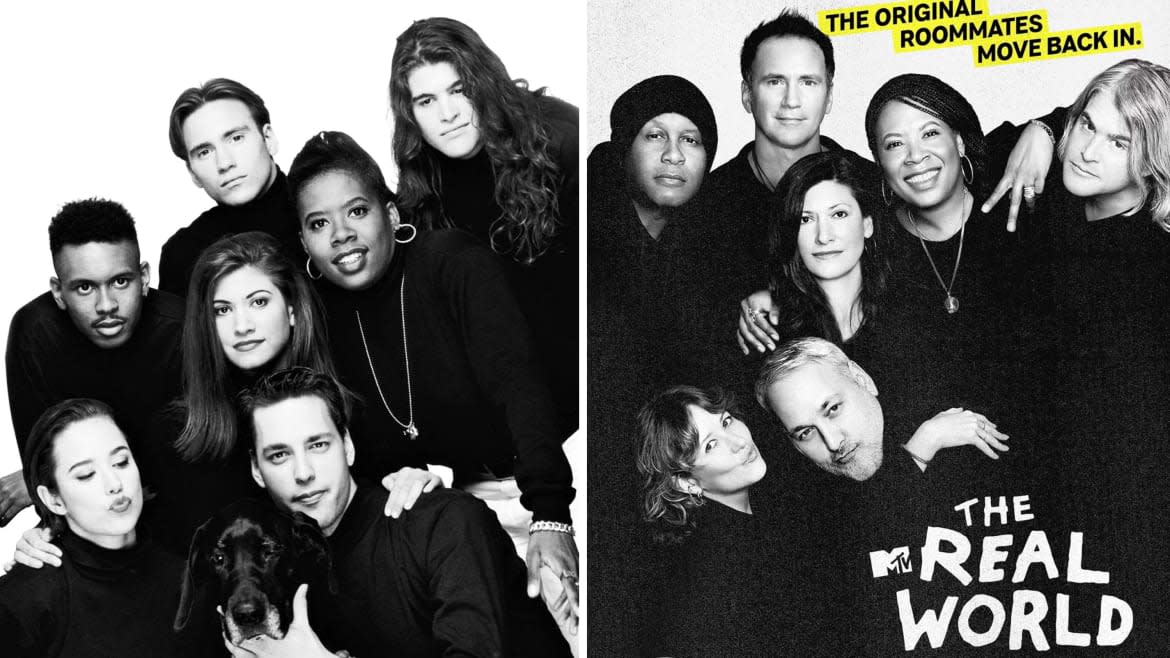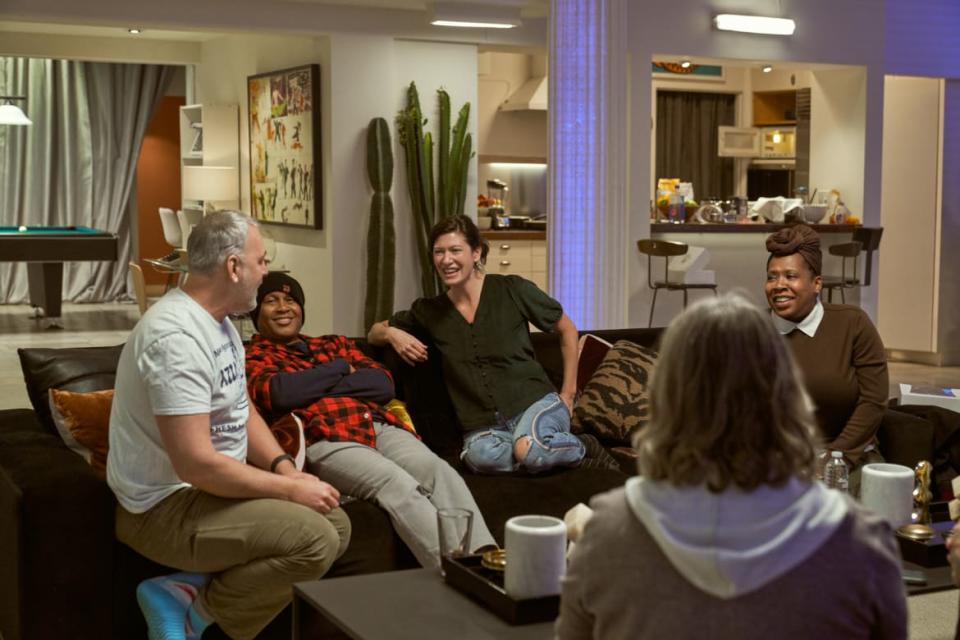‘The Real World Homecoming’ Reminds Us How the MTV Reality Show Changed America

- Oops!Something went wrong.Please try again later.
- Oops!Something went wrong.Please try again later.
Almost a decade after the launch of MTV in 1981, the network, which aired mostly music videos at the time, was looking to cash in on the success of soap operas. Burgeoning television producer Jonathan Murray and the late Mary-Ellis Bunim, who produced several daytime soaps, worked on a half-hour scripted series called St. Mark’s Place about a group of young adults living in the East Village that was ultimately rejected by the network’s executives due to its costly budget. Soon after, the pair pitched a low-cost solution known as The Real World. Its logline was simple: a serialized documentary about (originally) six young people from diverse backgrounds put up in a New York City loft. The series would introduce its subjects like television characters and create its own dramatic story arc through, as Murray put it, “growth and conflict” while avoiding the high costs of a Beverly Hills, 90210.
Instantly greenlit by the network, The Real World recruited an ensemble of creatives ranging from their late teens to mid-twenties: Rebecca “Becky” Blasband, a straight white female folk singer; Andre Comeau, a straight white male indie rocker; Heather Gardner, a straight Black female rapper; Julie Gentry, a straight white female dancer; Norman Korpi, a gay white male painter; Eric Nies, a straight white male model; and Kevin Powell, a straight Black male poet and writer. All of the cast identified as cisgender.
Dylan Sprouse Reckons With His Disney Past and Looks Toward the Future
Despite their similar and sometimes overlapping vocations, the cast members’ varying identities and outlooks on the world took center stage and provided most of the season’s drama, particularly Kevin’s heated interactions with his white roommates—as was The Real World’s ambition. As Murray, a gay white man, tells Amanda Ann Klein in her recently released book, Millennials Killed The Video Star, he wanted to document the “messy growth” that’s comes out of “interact[ing] with a diverse group of people.”
“I think it’s healthy to live in a diverse world,” he said. “It’s healthy to interact with a diverse group of people. You grow a lot.”
Almost 30 years later, The Real World Homecoming: New York, which arrives today on Paramount+ (formerly CBS All-Access), re-evaluates its own premise, intentionally or unintentionally, particularly Murray’s claim that diversifying our personal circles automatically creates a progressive outcome—and who these conversations are progressive for.
This approach is hinted at early on in the premiere when Kevin and Becky are waiting for the rest of their castmates to arrive at their original SoHo loft where they’ll be residing for a six-day reunion. Becky tells Kevin that, despite the time that’s passed since their initial meeting, America is still dealing with the “same shit.” It’s hardly an original statement, but nevertheless appropriate. Yesterday marked 30 years since Rodney King was brutally beaten by four white Los Angeles police officers, who would be acquitted on all but one charge (in never-before-seen footage from the original season, we see the castmates watching the LA riots on the news). And the year before Real World premiered in 1992, Anita Hill testified before Congress about the sexual harassment she allegedly endured under future Supreme Court Justice Clarence Thomas. Kevin remarks that these respective flashpoints are embedded in the current #MeToo and Black Lives Matter movements.
To be clear, it’s not that Bunim and Murray set out to end gendered violence and white supremacy on a systemic scale with their program. It is entertainment, after all. But the persistent lack of understanding surrounding these issues, despite advancements in representation and the amplification of marginalized voices through social media, says a lot about the unreliability of what writer Alex V. Green calls the “Having Conversations Industrial Complex” that’s intrinsic to the Real World.
The transformations that are most crucial to Murray’s hypothesis, of course, are those of cast members like Becky, who came off as indifferent to Kevin’s grievances about being Black in America during a heated argument in their original season. Likewise, Becky tells Kevin that she thinks the topic of racism due to Black Lives Matter has become “incendiary enough that we can finally put [it] to bed.” It’s clumsy but familiar phrasing from a white person that ignores the inherent “incendiary” quality of social unrest throughout history, and naively suggests that racism can be eradicated in a neat manner. Even before we get a glimpse of an upcoming episode in which Becky says she doesn’t want to be “a poster girl for white privilege,” we can assume that some of her “flaky liberal[ism]” Kevin once accused her of is still intact.
Before The Real World Homecoming dives into its signature polemics, including a rehashing of Kevin and Julie’s famous dispute on the sidewalk, again, about race, the premiere catches viewers up on the current lives of its cast members—like Andre, who has a 4-year-old daughter and seemingly more revelations to make to the house as the series goes on. Eric, who relays some unfortunate news to his roommates, turned his aimless partying into a sober, New Age lifestyle. Kevin remains an activist and says that he’s learned to “meet people where they are” and include other causes in his work, like feminism. Julie got married and had kids after the show ended. And the most we know about Norman so far is that he’s patented a laptop stand.

A scene from The Real World Homecoming: New York
The series also saves Heather’s story for later, particularly the status of her rap career. However, she remains the same vivacious spirit with hilarious one-liners to ease the nerves amongst the group and makes for the episode’s most entertaining moments. In one scene, she unconsciously does an update on her famous “can you get the phone?” line from the opening credits that reminds viewers these reboots can simply be a delightful act of fan service if nothing more.
Of course, a reboot of this show would feel inadequate without a proper contextualization of the Real World franchise in the landscape of television. The cast members still seemed just as shocked as they were after filming the season about their temporary celebrity status and the legacies they embody. It’s not just that the series forever changed MTV as a network, which was inevitable for multiple reasons, or increased a demand in series like it, but that it taught the generations that came after them, primarily millennials, how to exist in the world and optimize their image through self-branding and self-broadcasting. It may be harder to buy the moral promise of The Real World as storylines have been manipulated for dramatic effect over the years—and as we’re still dealing with the ramifications of a reality-television president, as Kevin points out. But looking back on the social experiment through the eyes of its first guinea pigs, it’s hard to outright reject Eric’s claim that “the world needed [The Real World] to evolve” in one way or the other.
Get our top stories in your inbox every day. Sign up now!
Daily Beast Membership: Beast Inside goes deeper on the stories that matter to you. Learn more.

